Assessment of TOPKAPI-X Applicability for Flood Events Simulation in Two Small Catchments in Saxony
Abstract
1. Introduction
Background and Rationale of the Current Project
2. Materials and Methods
2.1. Description of the Study Areas
2.1.1. Wernersbach Catchment
2.1.2. Wesenitz Catchment
2.2. Description of TOPKAPI-X
- (1)
- Any grid has eight possible flow directions instead of the original four directions;
- (2)
- The infiltration module is based on the Green-Ampt model, which allows the reproduction of Hortonian processes and accounts for the infiltration excess mechanism;
- (3)
- The second soil layer is added in order to reproduce different hydrological conditions;
- (4)
- The addition of the groundwater component based on the cellular automata with full 2D Integrated Finite Difference scheme;
- (5)
- Introduction of the new coefficients, which consider the sun height with respect to the cell aspect. This is used for the assessment of radiation and albedo in the snow accumulation and melting module based on mass and energy balance;
- (6)
- The addition of the Reservoir and Lake components.
2.3. Input Data
2.4. Model Calibration and Validation
3. Results
3.1. Calibration
3.1.1. Wernersbach (One Soil Layer)
3.1.2. Wernersbach (Two Soil Layers)
3.1.3. Wesenitz
3.2. Validation Period
3.2.1. Wernersbach
3.2.2. Wesenitz
4. Discussion
4.1. Sources of Error
4.1.1. Missing Data and the Lack of Precipitation Data
4.1.2. Spatial Distribution of Precipitation (Interpolation Method)
4.1.3. Lack of Information on Parameters and Resulting Uncertainties
4.1.4. Manual Calibration with One Aggregated Response
4.1.5. Insufficient or Inaccurate Processes
5. Conclusions
Author Contributions
Funding
Data Availability Statement
Conflicts of Interest
References
- Pestana, R.; Matias, M.; Canelas, R.; Araújo, A.; Roque, D.; Van Zeller, E.; Trigo-Teixeira, A.; Ferreira, R.; Oliveira, R.; Heleno, S. Calibration of 2D Hydraulic Inundation models in the Floodplain Region of the Lower Tagus River. In Proceedings of the ESA Living Planet Symposium, Edimburgh, UK, 9–13 September 2013. [Google Scholar]
- Ming, X.; Liang, Q.; Xia, X.; Li, D.; Fowler, H.J. Real-Time Flood Forecasting Based on a High-Performance 2-D Hydrodynamic Model and Numerical Weather Predictions. Water Resour. Res. 2020, 56, e2019WR025583. [Google Scholar] [CrossRef]
- Werner, M.; Reggiani, P.; Roo, A.D.; Bates, P.; Sprokkereef, E. Flood Forecasting and Warning at the River Basin and at the European Scale. Nat. Hazards 2005, 36, 25–42. [Google Scholar] [CrossRef]
- Xia, X.; Liang, Q.; Ming, X. A Full-Scale Fluvial Flood Modelling Framework Based on a High-Performance Integrated Hydrodynamic Modelling System (HiPIMS). Adv. Water Resour. 2019, 132, 103392. [Google Scholar] [CrossRef]
- Kalyanapu, A.J.; Burian, S.J.; McPherson, T.N. Effect of land use-based surface roughness on hydrologic model output. J. Spat. Hydrol. 2009, 9, 51–71. [Google Scholar]
- Soderman, D.; Meneguzzo, F.; Gozzini, B.; Grifoni, D.; Messeri, G.; Rossi, M.; Montagnani, S.; Pasqui, M.; Orlandi, A.; Ortolani, A.; et al. Very High Resolution Precipitation Forecasting on Low Cost High Performance Computer Systems in Support of Hydrological Modeling. In Proceedings of the 17th Conference on Hydrology, AMS Annual Meeting, Long Beach, CA, USA, 9–13 February 2003. [Google Scholar]
- De Roo, A.P.J.; Gouweleeuw, B.; Thielen, J.; Bartholmes, J.; Bongioannini-Cerlini, P.; Todini, E.; Bates, P.D.; Horritt, M.; Hunter, N.; Beven, K.; et al. Development of a European Flood Forecasting System. Int. J. River Basin Manag. 2003, 1, 49–59. [Google Scholar] [CrossRef]
- Caviedes-Voullième, D.; Fernández-Pato, J.; Hinz, C. Performance Assessment of 2D Zero-Inertia and Shallow Water Models for Simulating Rainfall-Runoff Processes. J. Hydrol. 2020, 584, 124663. [Google Scholar] [CrossRef]
- Viviroli, D.; Zappa, M.; Gurtz, J.; Weingartner, R. An introduction to the hydrological modelling system PREVAH and its pre- and post-processing-tools. Environ. Model. Softw. 2009, 24, 1209–1222. [Google Scholar] [CrossRef]
- Zhao, L.; Xia, J.; Xu, C.; Wang, Z.; Sobkowiak, L.; Long, C. Evapotranspiration estimation methods in hydrological models. J. Geogr. Sci. 2013, 23, 359–369. [Google Scholar] [CrossRef]
- Te Linde, A.H.; Aerts, J.C.J.H.; Hurkmans, R.T.W.L.; Eberle, M. Comparing model performance of two rainfall-runoff models in the Rhine basin using different atmospheric forcing data sets. Hydrol. Earth Syst. Sci. Discuss. 2007, 4, 4325–4360. [Google Scholar]
- Liu, J.; Chen, X.; Zhang, J.; Flury, M. Coupling the Xinanjiang model to a kinematic flow model based on digital drainage networks for flood forecasting. Hydrol. Process. 2009, 23, 1337–1348. [Google Scholar] [CrossRef]
- Koch, J.; Cornelissen, T.; Fang, Z.; Bogena, H.; Diekkrüger, B.; Kollet, S.; Stisen, S. Inter-Comparison of Three Distributed Hydrological Models with Respect to Seasonal Variability of Soil Moisture Patterns at a Small Forested Catchment. J. Hydrol. 2016, 533, 234–249. [Google Scholar] [CrossRef]
- Uhlenbrook, S. An Empirical Approach for Delineating Spatial Units with the Same Dominating Runoff Generation Processes. Phys. Chem. Earth Parts A/B/C 2003, 28, 297–303. [Google Scholar] [CrossRef]
- Todini, E. Hydrological catchment modelling: Past, present and future. Hydrol. Earth Syst. Sci. Discuss. 2007, 11, 468–482. [Google Scholar] [CrossRef]
- Chiew, F.H.S. Lumped Conceptual Rainfall-Runoff Models and Simple Water Balance Methods: Overview and Applications in Ungauged and Data Limited Regions. Geogr. Compass 2010, 4, 206–225. [Google Scholar] [CrossRef]
- Zhang, G.P.; Savenije, H.H.G. Rainfall-runoff modelling in a catchment with a complex groundwater flow system: Application of the Representative Elementary Watershed (REW) approach. Hydrol. Earth Syst. Sci. Discuss. 2005, 9, 243–261. [Google Scholar] [CrossRef]
- Yan, Y.; Tao, X.; Li, B.; Mazzetti, C. Application of hydrometeorological coupled European flood forecasting operational real time system in Yellow River Basin. Water Sci. Eng. 2009, 2, 28–39. [Google Scholar] [CrossRef]
- Paiva, R.C.D.; Collischonn, W.; Tucci, C.E.M. Large scale hydrologic and hydrodynamic modeling using limited data and a GIS based approach. J. Hydrol. 2011, 406, 170–181. [Google Scholar] [CrossRef]
- Kavetski, D.; Kuczera, G.; Franks, S.W. Semidistributed Hydrological Modeling: A “Saturation Path” Perspective on TOPMODEL and VIC. Water Resour. Res. 2003, 39. [Google Scholar] [CrossRef]
- Storck, P.; Bowling, L.; Wetherbee, P.; Lettenmaier, D. Application of a GIS-Based Distributed Hydrology Model for Prediction of Forest Harvest Effects on Peak Stream Flow in the Pacific Northwest. Hydrol. Process. 1998, 12, 889–904. [Google Scholar] [CrossRef]
- Fatichi, S.; Vivoni, E.R.; Ogden, F.L.; Ivanov, V.Y.; Mirus, B.; Gochis, D.; Downer, C.W.; Camporese, M.; Davison, J.H.; Ebel, B.; et al. An Overview of Current Applications, Challenges, and Future Trends in Distributed Process-Based Models in Hydrology. J. Hydrol. 2016, 537, 45–60. [Google Scholar] [CrossRef]
- Martina, M.L.V.; Todini, E.; Liu, Z. Preserving the dominant physical processes in a lumped hydrological model. J. Hydrol. 2011, 399, 121–131. [Google Scholar] [CrossRef]
- Hapuarachchi, H.A.P.; Wang, Q.J.; Pagano, T.C. A Review of Advances in Flash Flood Forecasting. Hydrol. Process. 2011, 25, 2771–2784. [Google Scholar] [CrossRef]
- Zhao, G.; Hörmann, G.; Fohrer, N.; Gao, J.; Li, H.; Tian, P. Application of a Simple Raster-Based Hydrological Model for Streamflow Prediction in a Humid Catchment with Polder Systems. Water Resour. Manag. 2011, 25, 661–676. [Google Scholar] [CrossRef]
- Khakbaz, B.; Imam, B.; Hsu, K.; Sorooshian, S. From lumped to distributed via semi-distributed: Calibration strategies for semi-distributed hydrologic models. J. Hydrol. 2012, 418–419, 61–77. [Google Scholar] [CrossRef]
- Sayama, T.; Tachikawa, Y.; Takara, K. Spatial lumping of a distributed rainfall-sediment-runoff model and its effective lumping scale. Hydrol. Process. 2012, 26, 855–871. [Google Scholar] [CrossRef]
- Finger, D.; Pellicciotti, F.; Konz, M.; Rimkus, S.; Burlando, P. The value of glacier mass balance, satellite snow cover images, and hourly discharge for improving the performance of a physically based distributed hydrological model. Water Resour. Res. 2011, 47. [Google Scholar] [CrossRef]
- Aureli, F.; Prost, F.; Vacondio, R.; Dazzi, S.; Ferrari, A. A GPU-Accelerated Shallow-Water Scheme for Surface Runoff Simulations. Water 2020, 12, 637. [Google Scholar] [CrossRef]
- Ragettli, S.; Pellicciotti, F. Calibration of a physically based, spatially distributed hydrological model in a glacierized basin: On the use of knowledge from glaciometeorological processes to constrain model parameters. Water Resour. Res. 2012, 48. [Google Scholar] [CrossRef]
- Elsafi, S.H. Artificial Neural Networks (ANNs) for flood forecasting at Dongola Station in the River Nile, Sudan. Alex. Eng. J. 2014, 53, 655–662. [Google Scholar] [CrossRef]
- Liu, Z.; Martina, M.L.V.; Todini, E. Flood forecasting using a fully distributed model: Application of the TOPKAPI model to the Upper Xixian Catchment. Hydrol. Earth Syst. Sci. Discuss. 2005, 9, 347–364. [Google Scholar] [CrossRef]
- McMillan, H.K.; Booker, D.J.; Cattoën, C. Validation of a national hydrological model. J. Hydrol. 2016, 541, 800–815. [Google Scholar] [CrossRef]
- Grayson, R.B.; Blöschl, G.; Western, A.W.; McMahon, T.A. Advances in the use of observed spatial patterns of catchment hydrological response. Adv. Water Resour. 2002, 25, 1313–1334. [Google Scholar] [CrossRef]
- Costabile, P.; Costanzo, C.; Ferraro, D.; Macchione, F.; Petaccia, G. Performances of the New HEC-RAS Version 5 for 2-D Hydrodynamic-Based Rainfall-Runoff Simulations at Basin Scale: Comparison with a State-of-the Art Model. Water 2020, 12, 2326. [Google Scholar] [CrossRef]
- Ferraro, D.; Costabile, P.; Costanzo, C.; Petaccia, G.; Macchione, F. A Spectral Analysis Approach for the a Priori Generation of Computational Grids in the 2-D Hydrodynamic-Based Runoff Simulations at a Basin Scale. J. Hydrol. 2020, 582, 124508. [Google Scholar] [CrossRef]
- Fernández-Pato, J.; Martínez-Aranda, S.; García-Navarro, P. A 2D Finite Volume Simulation Tool to Enable the Assessment of Combined Hydrological and Morphodynamical Processes in Mountain Catchments. Adv. Water Resour. 2020, 141, 103617. [Google Scholar] [CrossRef]
- Ni, Y.; Cao, Z.; Liu, Q.; Liu, Q. A 2D Hydrodynamic Model for Shallow Water Flows with Significant Infiltration Losses. Hydrol. Process. 2020, 34, 2263–2280. [Google Scholar] [CrossRef]
- Cea, L.; Bladé, E. A Simple and Efficient Unstructured Finite Volume Scheme for Solving the Shallow Water Equations in Overland Flow Applications. Water Resour. Res. 2015, 51, 5464–5486. [Google Scholar] [CrossRef]
- Bout, B.; Jetten, V.G. The Validity of Flow Approximations When Simulating Catchment-Integrated Flash Floods. J. Hydrol. 2018, 556, 674–688. [Google Scholar] [CrossRef]
- Hou, J.; Wang, R.; Liang, Q.; Li, Z.; Huang, M.S.; Hinkelmann, R. Efficient Surface Water Flow Simulation on Static Cartesian Grid with Local Refinement According to Key Topographic Features. Comput. Fluids 2018, 176, 117–134. [Google Scholar] [CrossRef]
- Ciarapica, L.; Todini, E. TOPKAPI: A model for the representation of the rainfall-runoff process at different scales. Hydrol. Process. 2002, 16, 207–229. [Google Scholar] [CrossRef]
- Vischel, T.; Pegram, G.; Sinclair, S.; Parak, M. Implementation of the TOPKAPI model in South Africa: Initial results from the Liebenbergsvlei catchment. Water Sa 2008, 34, 331–342. [Google Scholar] [CrossRef]
- Bøggild, C.E.; Knudby, C.J.; Knudsen, M.B.; Starzer, W. Snowmelt and Runoff Modelling of an Arctic Hydrological Basin in West Greenland. Hydrol. Process. 1999, 13, 1989–2002. [Google Scholar] [CrossRef]
- McMichael, C.E.; Hope, A.S.; Loaiciga, H.A. Distributed Hydrological Modelling in California Semi-Arid Shrublands: MIKE SHE Model Calibration and Uncertainty Estimation. J. Hydrol. 2006, 317, 307–324. [Google Scholar] [CrossRef]
- Vázquez, R.F.; Feyen, J. Assessment of the Effects of DEM Gridding on the Predictions of Basin Runoff Using MIKE SHE and a Modelling Resolution of 600m. J. Hydrol. 2007, 334, 73–87. [Google Scholar] [CrossRef]
- Golmohammadi, G.; Prasher, S.; Madani, A.; Rudra, R. Evaluating Three Hydrological Distributed Watershed Models: MIKE-SHE, APEX, SWAT. Hydrology 2014, 1, 20–39. [Google Scholar] [CrossRef]
- Sandu, M.-A.; Virsta, A. Applicability of MIKE SHE to Simulate Hydrology in Argesel River Catchment. Agric. Agric. Sci. Procedia 2015, 6, 517–524. [Google Scholar] [CrossRef]
- De Roo, A.; Odijk, M.; Schmuck, G.; Koster, E.; Lucieer, A. Assessing the effects of land use changes on floods in the meuse and oder catchment. Phys. Chem. Earth Part B Hydrol. Ocean. Atmos. 2001, 26, 593–599. [Google Scholar] [CrossRef]
- Pappenberger, F.; Beven, K.; Roo, A.D.; Thielen, J.; Gouweleeuw, B. Uncertainty Analysis of the Rainfall Runoff Model LisFlood within the Generalized Likelihood Uncertainty Estimation (GLUE). Int. J. River Basin Manag. 2004, 2, 123–133. [Google Scholar] [CrossRef]
- Coulthard, T.J.; Neal, J.C.; Bates, P.D.; Ramirez, J.; de Almeida, G.A.M.; Hancock, G.R. Integrating the LISFLOOD-FP 2D Hydrodynamic Model with the CAESAR Model: Implications for Modelling Landscape Evolution. Earth Surf. Process. Landf. 2013, 38, 1897–1906. [Google Scholar] [CrossRef]
- Bandaragoda, C.; Tarboton, D.G.; Woods, R. Application of TOPNET in the Distributed Model Intercomparison Project. J. Hydrol. 2004, 298, 178–201. [Google Scholar] [CrossRef]
- Clark, M.P.; Rupp, D.E.; Woods, R.A.; Zheng, X.; Ibbitt, R.P.; Slater, A.G.; Schmidt, J.; Uddstrom, M.J. Hydrological Data Assimilation with the Ensemble Kalman Filter: Use of Streamflow Observations to Update States in a Distributed Hydrological Model. Adv. Water Resour. 2008, 31, 1309–1324. [Google Scholar] [CrossRef]
- Bertoldi, G.; Rigon, R. GEOTOP: A Hydrological Balance Model: Technical Description and Programs Guide, Version 0.75; University of Trento: Trento, Italy, 2004. [Google Scholar]
- Zanotti, F.; Endrizzi, S.; Bertoldi, G.; Rigon, R. The GEOTOP Snow Module. Hydrol. Process. 2004, 18, 3667–3679. [Google Scholar] [CrossRef]
- Rigon, R.; Bertoldi, G.; Over, T.M. GEOtop: A Distributed Hydrological Model with Coupled Water and Energy Budgets. J. Hydrometeorol. 2006, 7, 371–388. [Google Scholar] [CrossRef]
- Endrizzi, S.; Gruber, S.; Dall’Amico, M.; Rigon, R. GEOtop 2.0: Simulating the Combined Energy and Water Balance at and below the Land Surface Accounting for Soil Freezing, Snow Cover and Terrain Effects. Geosci. Model Dev. 2014, 7, 2831–2857. [Google Scholar] [CrossRef]
- Manfreda, S.; Fiorentino, M.; Iacobellis, V. DREAM: A Distributed Model for Runoff, Evapotranspiration, and Antecedent Soil Moisture Simulation. Adv. Geosci. 2005, 2, 31–39. [Google Scholar] [CrossRef]
- Franchini, M.; Pacciani, M. Comparative Analysis of Several Conceptual Rainfall-Runoff Models. J. Hydrol. 1991, 122, 161–219. [Google Scholar] [CrossRef]
- Todini, E. The ARNO Rainfall—Runoff Model. J. Hydrol. 1996, 175, 339–382. [Google Scholar] [CrossRef]
- Abdulla, F.A.; Lettenmaier, D.P.; Liang, X. Estimation of the ARNO Model Baseflow Parameters Using Daily Streamflow Data. J. Hydrol. 1999, 222, 37–54. [Google Scholar] [CrossRef]
- Beven, K.J.; Kirkby, M.J.; Schofield, N.; Tagg, A.F. Testing a Physically-Based Flood Forecasting Model (TOPMODEL) for Three UK Catchments. J. Hydrol. 1984, 69, 119–143. [Google Scholar] [CrossRef]
- Beven, K.J.; Lamb, R.; Quinn, R.; Romanowicz, R.; Freer, J. Topmodel. In Computer Models of Watershed Hydrology; Water Resource Publications: Littleton, CO, USA, 1995; pp. 627–668. [Google Scholar]
- Franchini, M.; Wendling, J.; Obled, C.; Todini, E. Physical Interpretation and Sensitivity Analysis of the TOPMODEL. J. Hydrol. 1996, 175, 293–338. [Google Scholar] [CrossRef]
- Beven, K. TOPMODEL: A Critique. Hydrol. Process. 1997, 11, 1069–1085. [Google Scholar] [CrossRef]
- Holko, L.; Lepistö, A. Modelling the Hydrological Behaviour of a Mountain Catchment Using TOPMODEL. J. Hydrol. 1997, 196, 361–377. [Google Scholar] [CrossRef]
- Güntner, A.; Uhlenbrook, S.; Seibert, J.; Leibundgut, C. Multi-Criterial Validation of TOPMODEL in a Mountainous Catchment. Hydrol. Process. 1999, 13, 1603–1620. [Google Scholar] [CrossRef]
- Liu, Z.; Todini, E. Assessing the TOPKAPI non-linear reservoir cascade approximation by means of a characteristic lines solution. Hydrol. Process. 2005, 19, 1983–2006. [Google Scholar] [CrossRef]
- Konz, M.; Chiari, M.; Rimkus, S.; Turowski, J.M.; Molnar, P.; Rickenmann, D.; Burlando, P. Sediment Transport Modelling in a Distributed Physically Based Hydrological Catchment Model. Hydrol. Earth Syst. Sci. 2011, 15, 2821–2837. [Google Scholar] [CrossRef]
- Lindsay, J.B.; Rothwell, J.J.; Davies, H. Mapping outlet points used for watershed delineation onto DEM-derived stream networks. Water Resour. Res. 2008, 44. [Google Scholar] [CrossRef]
- Foglia, L.; Hill, M.C.; Mehl, S.W.; Burlando, P. Sensitivity analysis, calibration, and testing of a distributed hydrological model using error-based weighting and one objective function. Water Resour. Res. 2009, 45. [Google Scholar] [CrossRef]
- Sinclair, S.; Pegram, G.G.S. A comparison of ASCAT and modelled soil moisture over South Africa, using TOPKAPI in land surface mode. Hydrol. Earth Syst. Sci. 2010, 14, 613–626. [Google Scholar] [CrossRef]
- Sinclair, S.; Pegram, G.G.S. A sensitivity assessment of the TOPKAPI model with an added infiltration module. J. Hydrol. 2013, 479, 100–112. [Google Scholar] [CrossRef]
- Peng, D.; Zhijia, L.; Zhiyu, L. Numerical algorithm of distributed TOPKAPI model and its application. Water Sci. Eng. 2008, 1, 14–21. [Google Scholar] [CrossRef]
- Pellicciotti, F.; Buergi, C.; Immerzeel, W.W.; Konz, M.; Shrestha, A.B. Challenges and Uncertainties in Hydrological Modeling of Remote Hindu Kush–Karakoram–Himalayan (HKH.) Basins: Suggestions for Calibration Strategies. Mred 2012, 32, 39–50. [Google Scholar] [CrossRef]
- Immerzeel, W.W.; Petersen, L.; Ragettli, S.; Pellicciotti, F. The importance of observed gradients of air temperature and precipitation for modeling runoff from a glacierized watershed in the Nepalese Himalayas. Water Resour. Res. 2014, 50, 2212–2226. [Google Scholar] [CrossRef]
- Amengual, A.; Diomede, T.; Marsigli, C.; Martín, A.; Morgillo, A.; Romero, R.; Papetti, P.; Alonso, S. A Hydrometeorological Model Intercomparison as a Tool to Quantify the Forecast Uncertainty in a Medium Size Basin. Nat. Hazards Earth Syst. Sci. 2008, 8, 819–838. [Google Scholar] [CrossRef][Green Version]
- Ortiz, E.; Michele, C.D.; Todini, E.; Cifres, E. Global system for hydrological monitoring and forecasting in real time at high resolution. In Proceedings of the Geophysical Research Abstracts, Vienna, Austria, 17–22 April 2016; Volume 18, p. 3. [Google Scholar]
- Ortiz, E.; Coccia, G.; Todini, E. An Operational Real-Time Flood Forecasting System in Southern Italy. In Proceedings of the EGU General Assembly Conference Abstracts, Vienna, Austria, 12–17 April 2015. [Google Scholar]
- Schwärzel, K.; Feger, K.-H.; Häntzschel, J.; Menzer, A.; Spank, U.; Clausnitzer, F.; Köstner, B.; Bernhofer, C. A novel approach in model-based mapping of soil water conditions at forest sites. For. Ecol. Manag. 2009, 258, 2163–2174. [Google Scholar] [CrossRef]
- Sukhodolov, A.N.; Nikora, V. Bursting and flow kinematics in natural streams. In Aquananotechnology: Global Prospects; River Flow; Taylor & Francis Group: London, UK, 2012; pp. 113–120. ISBN 978-0-415-62129-8. [Google Scholar]
- Eltner, A.; Sardemann, H.; Kröhnert, M.; Maas, H.-G. Entwicklung eines low-cost Kamerapegels zur Erfassung hydrologischer Extremereignisse. Fernerkund. Geoinf. eV 2018, 27, 38. [Google Scholar]
- De Waele, J.; Martina, M.L.V.; Sanna, L.; Cabras, S.; Cossu, Q.A. Flash flood hydrology in karstic terrain: Flumineddu Canyon, central-east Sardinia. Geomorphology 2010, 120, 162–173. [Google Scholar] [CrossRef]
- Davolio, S.; Miglietta, M.M.; Diomede, T.; Marsigli, C.; Montani, A. A flood episode in northern Italy: Multi-model and single-model mesoscale meteorological ensembles for hydrological predictions. Hydrol. Earth Syst. Sci. 2013, 17, 2107–2120. [Google Scholar] [CrossRef]
- Coccia, G.; Mazzetti, C.; Ortiz, E.; Todini, E. Application of the Topkapi Model within the Dmip 2 Project. In Proceedings of the 23rd Conference on Hydrology, San Antonio, TX, USA, 10–12 January 2009. [Google Scholar]
- Liu, Z.; Todini, E. Towards a comprehensive physically-based rainfall-runoff model. Hydrol. Earth Syst. Sci. Discuss. 2002, 6, 859–881. [Google Scholar] [CrossRef]
- Nistor, M.-M.; Gualtieri, A.F.; Cheval, S.; Dezsi, Ş.; Boţan, V.E. Climate change effects on crop evapotranspiration in the Carpathian Region from 1961 to 2010. Meteorol. Appl. 2016, 23, 462–469. [Google Scholar] [CrossRef]
- Revilla-Romero, B.; Beck, H.E.; Burek, P.; Salamon, P.; de Roo, A.; Thielen, J. Filling the gaps: Calibrating a rainfall-runoff model using satellite-derived surface water extent. Remote Sens. Environ. 2015, 171, 118–131. [Google Scholar] [CrossRef]
- Vaze, J.; Jordan, P.; Beecham, R.; Frost, A.; Summerell, G. Guidelines for Rainfall-Runoff Modelling: Towards Best Practice Model Application; eWater Ltd.: San Francisco, CA, USA, 2011; p. 48. [Google Scholar]
- Ritter, A.; Muñoz-Carpena, R. Performance evaluation of hydrological models: Statistical significance for reducing subjectivity in goodness-of-fit assessments. J. Hydrol. 2013, 480, 33–45. [Google Scholar] [CrossRef]
- Coffey, M.; Workman, S.R.; Taraba, J.L.; Fogle, A.W. Statistical procedures for evaluating daily and monthly hydrologic model predictions. Trans. Asae 2004, 47, 59–68. [Google Scholar] [CrossRef]
- Pereira, D.; Dos, R.; Martinez, M.A.; de Almeida, A.Q.; Pruski, F.F.; Silva, D.D.; Zonta, J.H. Hydrological Simulation Using SWAT Model in Headwater Basin in Southeast Brazil. Eng. Agríc. 2014, 34, 789–799. [Google Scholar] [CrossRef]
- Pool, S.; Vis, M.; Seibert, J. Evaluating Model Performance: Towards a Non-Parametric Variant of the Kling-Gupta Efficiency. Hydrol. Sci. J. 2018, 63, 1941–1953. [Google Scholar] [CrossRef]
- Merz, R.; Parajka, J.; Blöschl, G. Scale Effects in Conceptual Hydrological Modeling. Water Resour. Res. 2009, 45. [Google Scholar] [CrossRef]
- Peschke, G.; Etzenberg, C.; Müller, G. Experimental analysis of different runoff generation mechanisms. In Proceedings of the Catchment Hydrological and Biochemical Processes in the Changing Environment, Liblice, Czech Republic, 22–24 September 1998; pp. 203–207. [Google Scholar]
- Krause, P.; Boyle, D.P.; Bäse, F. Comparison of different efficiency criteria for hydrological model assessment. Adv. Geosci. 2005, 5, 89–97. [Google Scholar] [CrossRef]
- Gupta, H.V.; Kling, H.; Yilmaz, K.K.; Martinez, G.F. Decomposition of the mean squared error and NSE performance criteria: Implications for improving hydrological modelling. J. Hydrol. 2009, 377, 80–91. [Google Scholar] [CrossRef]
- Teegavarapu, R.S.V.; Chandramouli, V. Improved weighting methods, deterministic and stochastic data-driven models for estimation of missing precipitation records. J. Hydrol. 2005, 312, 191–206. [Google Scholar] [CrossRef]
- Mandapaka, P.V.; Krajewski, W.F.; Mantilla, R.; Gupta, V.K. Dissecting the effect of rainfall variability on the statistical structure of peak flows. Adv. Water Resour. 2009, 32, 1508–1525. [Google Scholar] [CrossRef]
- Sitterson, J.; Knightes, C.; Parmar, R.; Wolfe, K.; Avant, B.; Muche, M. An Overview of Rainfall-Runoff Model Types. In Proceedings of the Modelling for Sustainable Food-Energy-Water Systems, Fort Collins, CO, USA, 24–28 June 2018. [Google Scholar]
- Diomede, T.; Davolio, S.; Marsigli, C.; Miglietta, M.M.; Moscatello, A.; Papetti, P.; Paccagnella, T.; Buzzi, A.; Malguzzi, P. Discharge prediction based on multi-model precipitation forecasts. Meteorol. Atmos. Phys. 2008, 101, 245–265. [Google Scholar] [CrossRef]
- Ly, S.; Charles, C.; Degré, A. Different methods for spatial interpolation of rainfall data for operational hydrology and hydrological modeling at watershed scale: A review. Biotechnol. Agron. Société Environ. 2013, 17, 392–406. [Google Scholar]
- Paschalis, A.; Fatichi, S.; Molnar, P.; Rimkus, S.; Burlando, P. On the effects of small scale space–time variability of rainfall on basin flood response. J. Hydrol. 2014, 514, 313–327. [Google Scholar] [CrossRef]
- Basistha, A.; Arya, D.S.; Goel, N.K. Spatial Distribution of Rainfall in Indian Himalayas A Case Study of Uttarakhand Region. Water Resour Manag. 2008, 22, 1325–1346. [Google Scholar] [CrossRef]
- Beven, K.; Freer, J. A dynamic TOPMODEL. Hydrol. Process. 2001, 15, 1993–2011. [Google Scholar] [CrossRef]
- Cheng, K.-S.; Lien, Y.-T.; Wu, Y.-C.; Su, Y.-F. On the criteria of model performance evaluation for real-time flood forecasting. Stoch Environ. Res Risk Assess 2017, 31, 1123–1146. [Google Scholar] [CrossRef]
- Daniel, E.B.; Camp, J.V.; LeBoeuf, E.J.; Penrod, J.R.; Dobbins, J.P.; Abkowitz, M.D. Watershed Modeling and its Applications: A State-of-the-Art Review. Open Hydrol. J. 2011, 5. [Google Scholar] [CrossRef]
- Konz, M.; Finger, D.; Bürgi, C.; Normand, S.; Immerzeel, W.W.; Merz, J.; Giriraj, A.; Burlando, P. Calibration of a distributed hydrological model for simulations of remote glacierized Himalayan catchments using MODIS snow cover data. In Proceedings of the Global Change: Facing Risks and Threats to Water Resource, Fez, Morocco, 25–29 October 2010; pp. 465–473. [Google Scholar]
- Savenije, H.H.G. The importance of interception and why we should delete the term evapotranspiration from our vocabulary. Hydrol. Process. 2004, 18, 1507–1511. [Google Scholar] [CrossRef]
- Sun, G.; Domec, J.-C.; Amatya, D. Forest evapotranspiration: Measurements and modeling at multiple scales. In Forest Hydrology: Processes, Management and Assessment; CABI Publishers: Wallingford, UK, 2016; pp. 32–50. ISBN 978-1-78064-660-2. [Google Scholar]
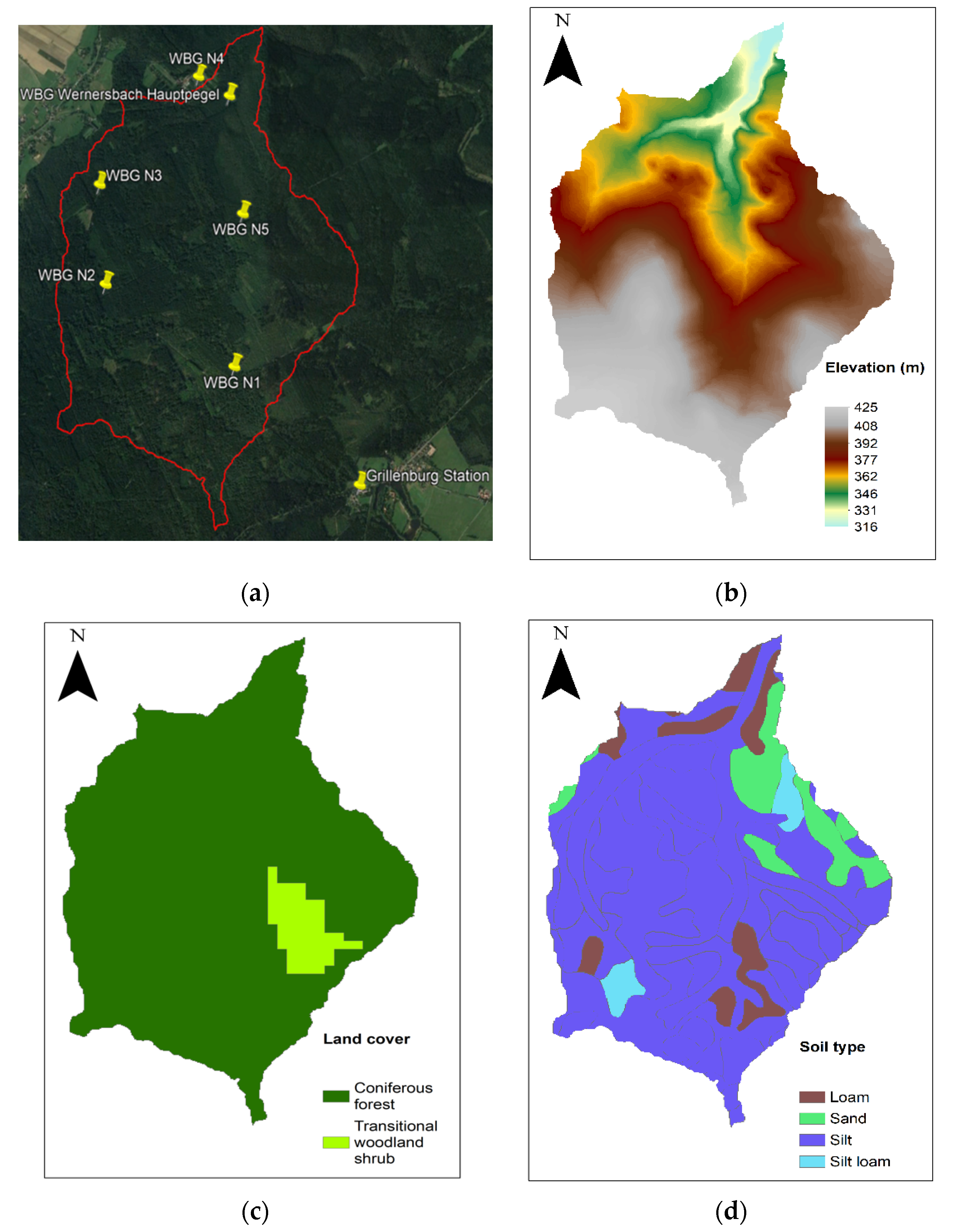
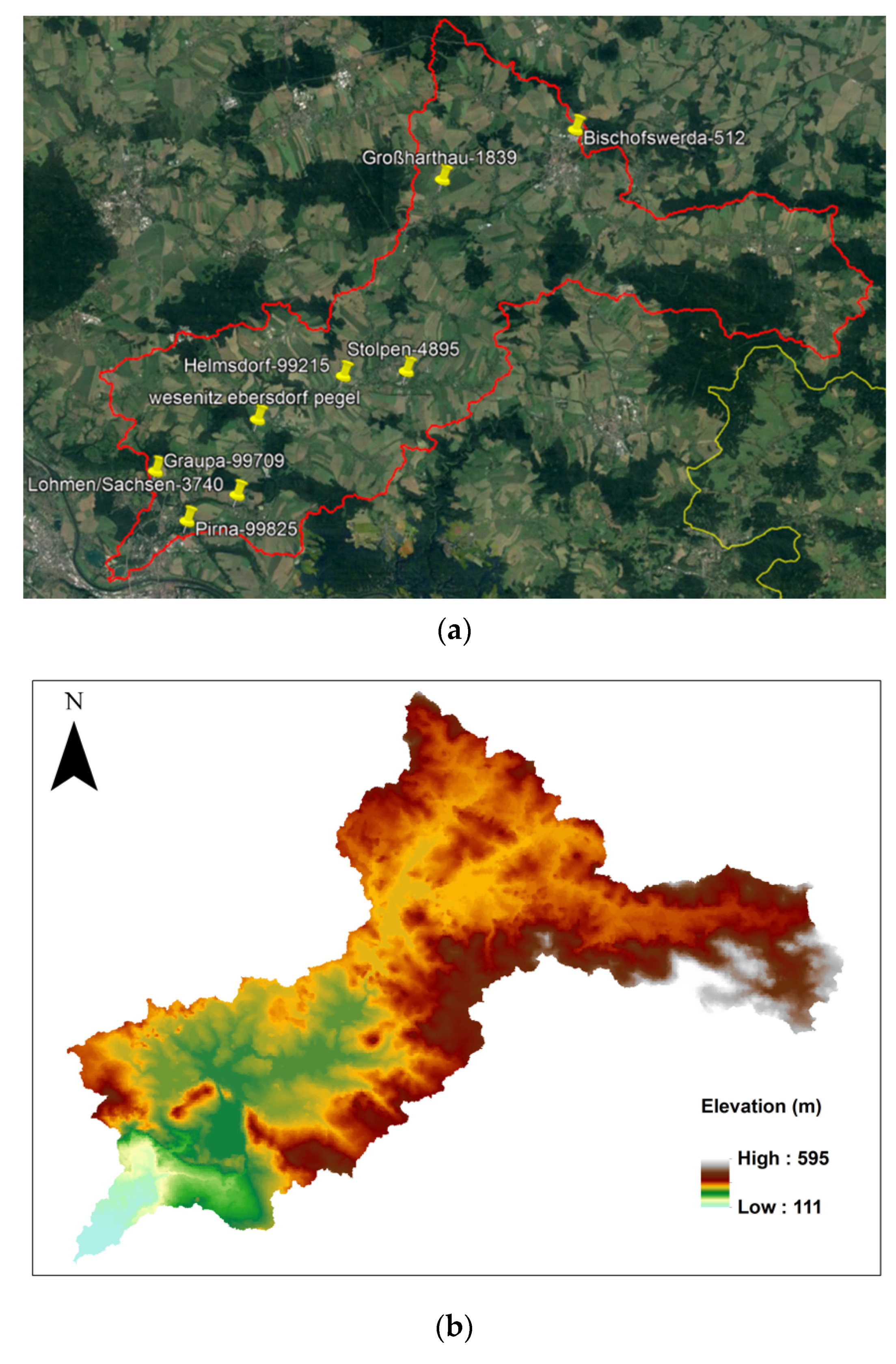
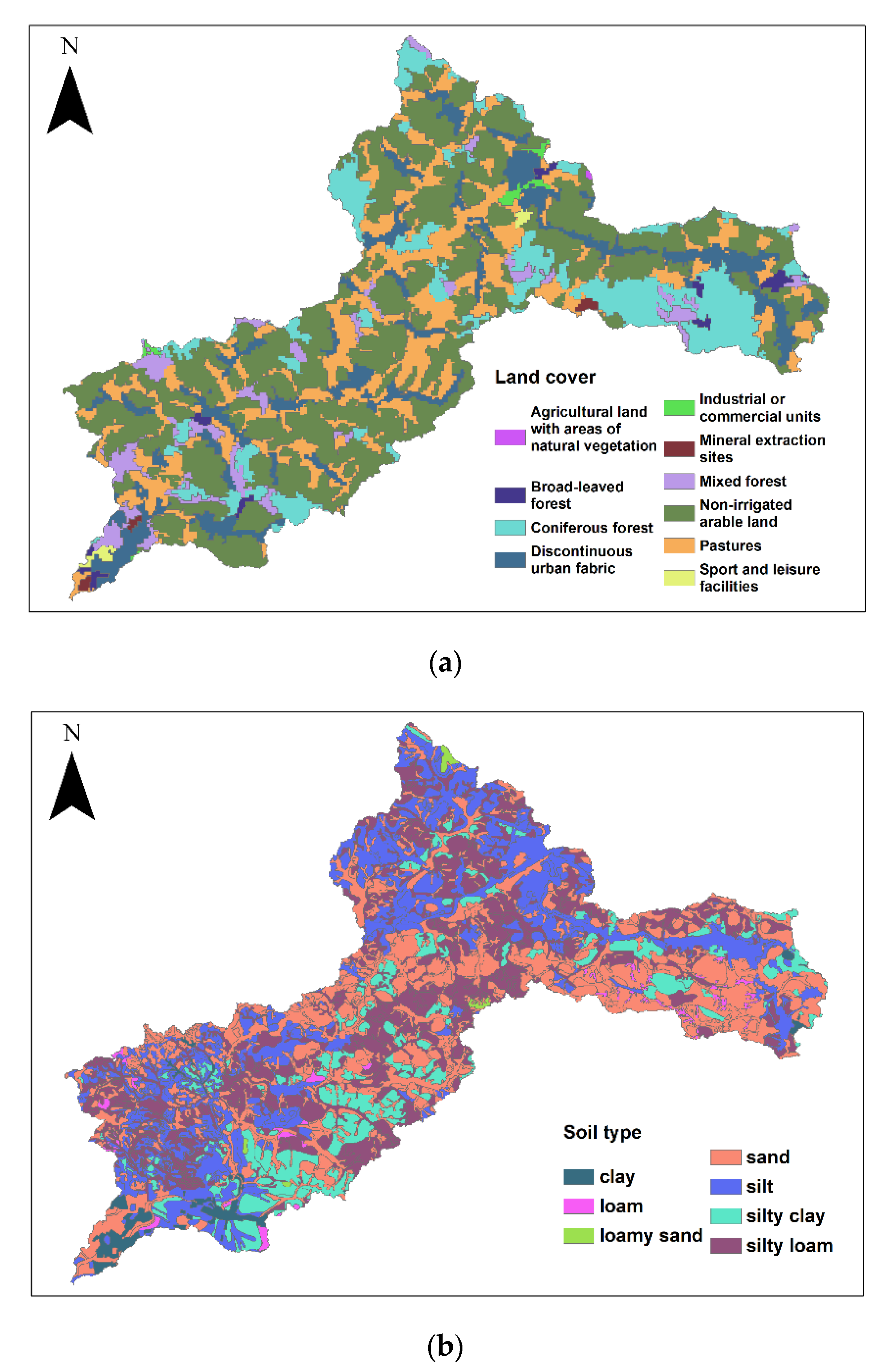
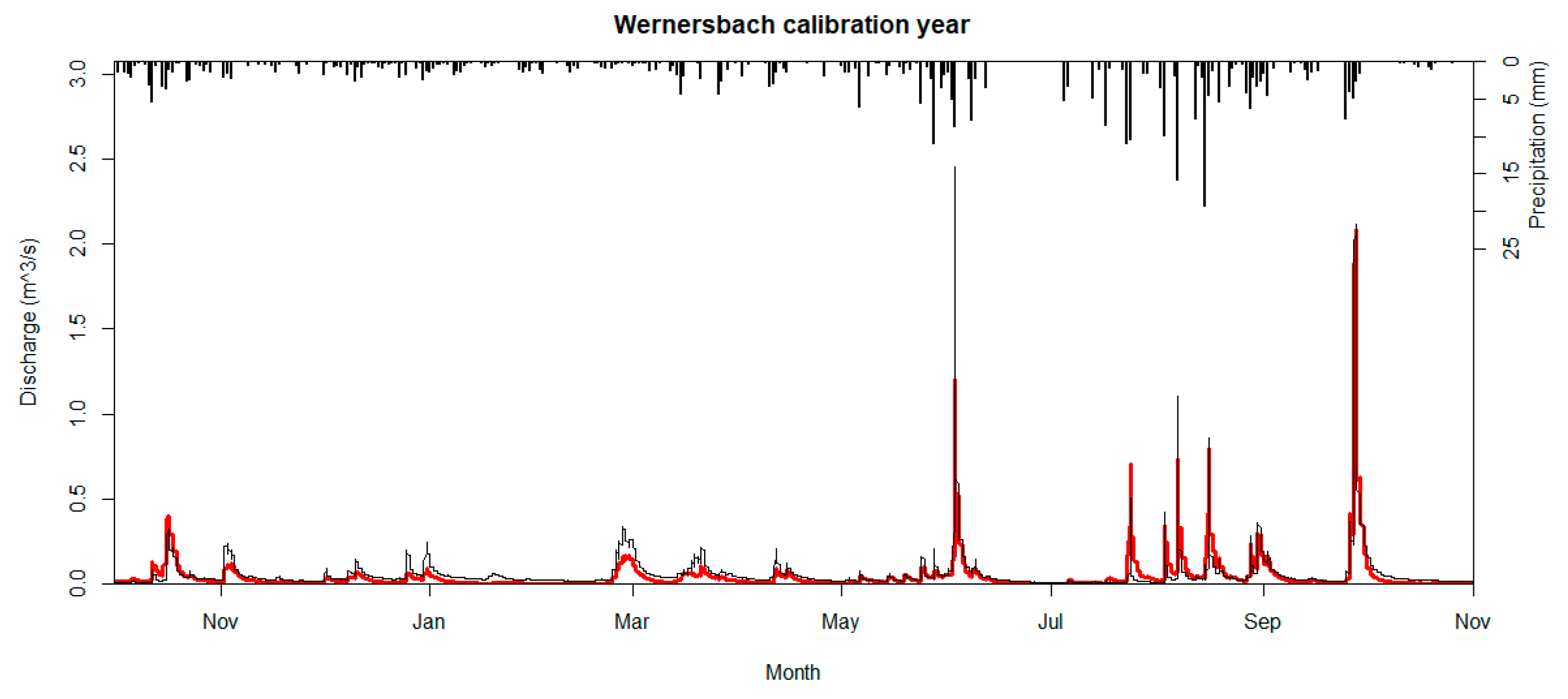
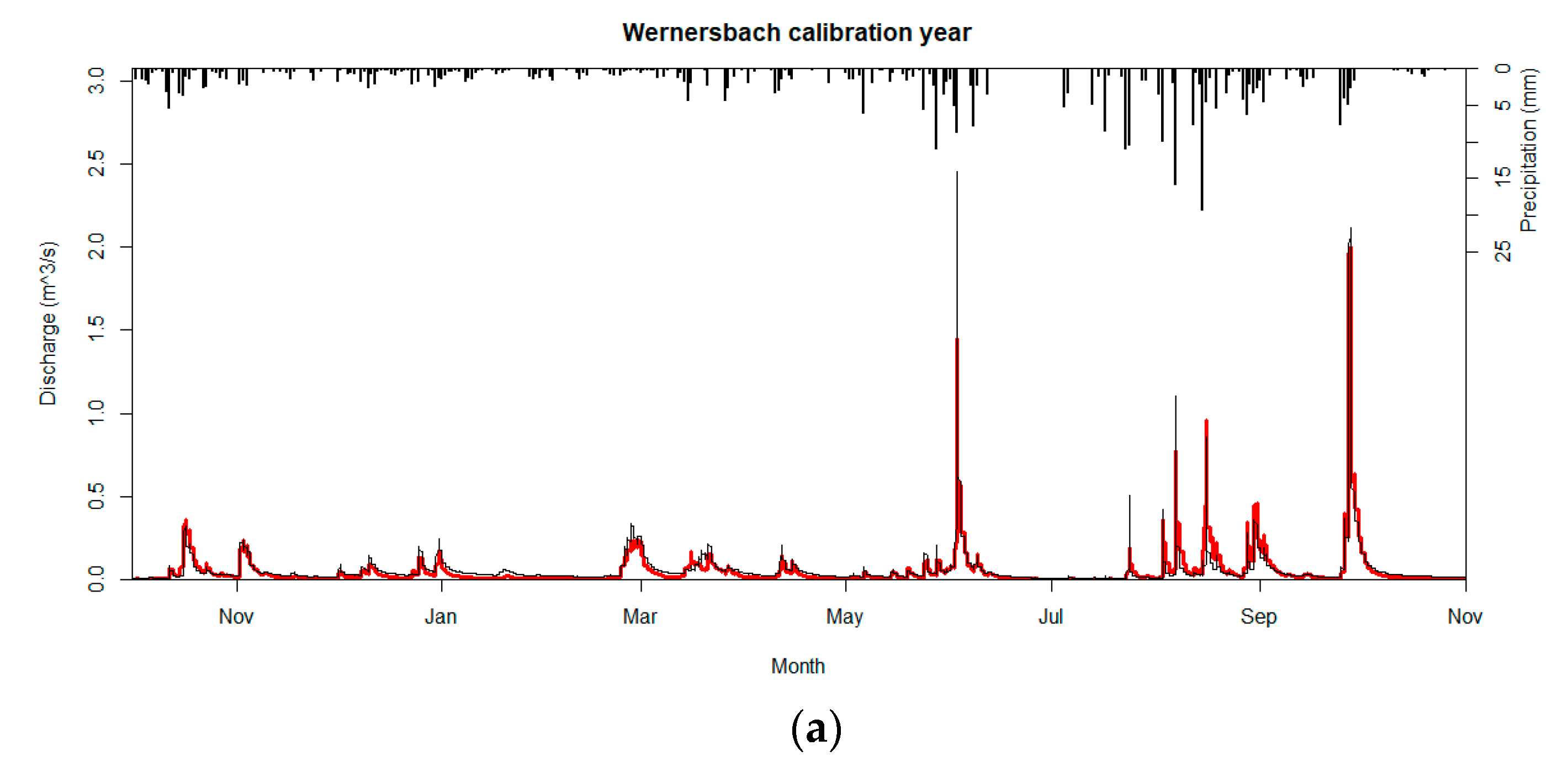
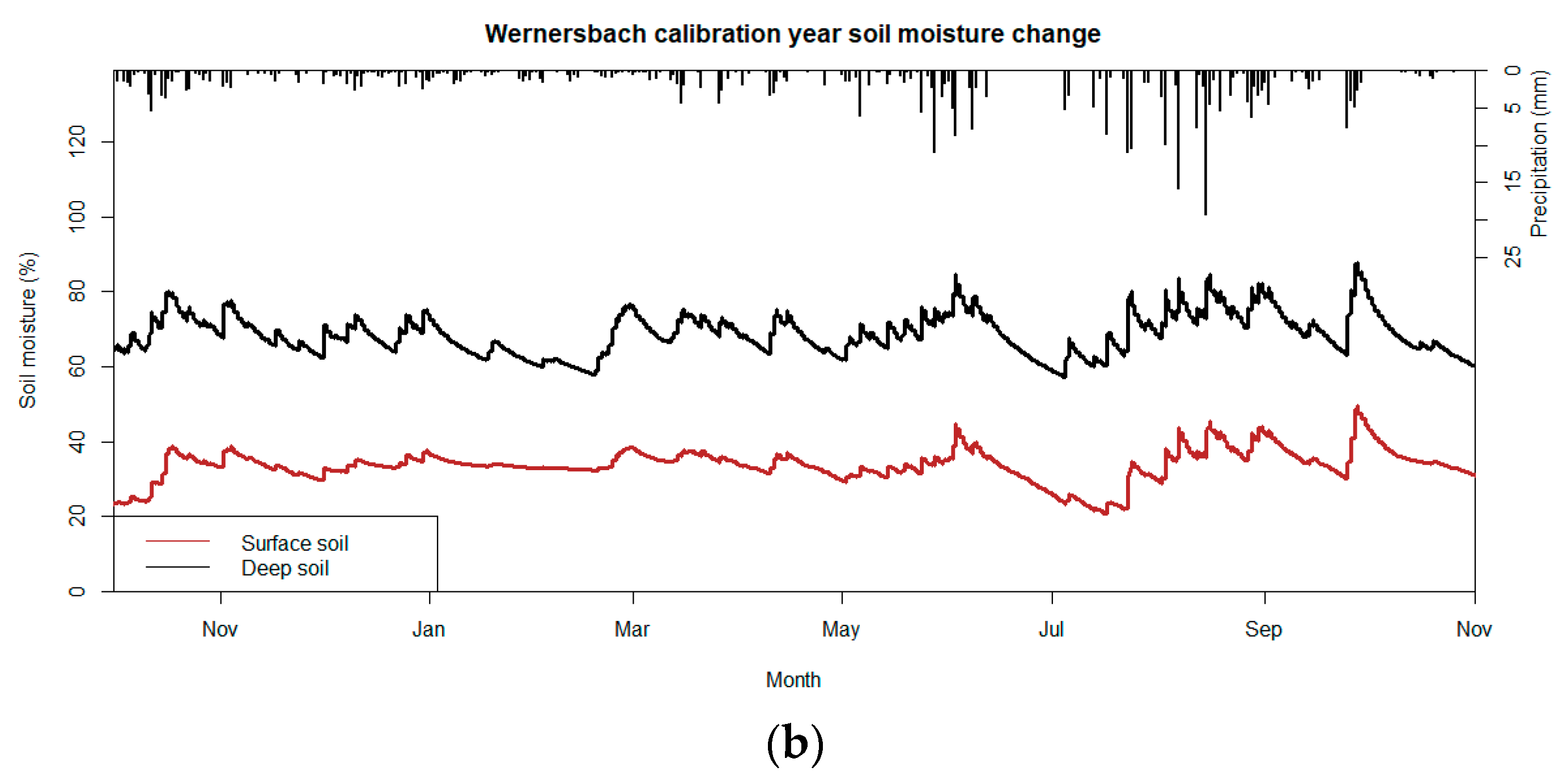
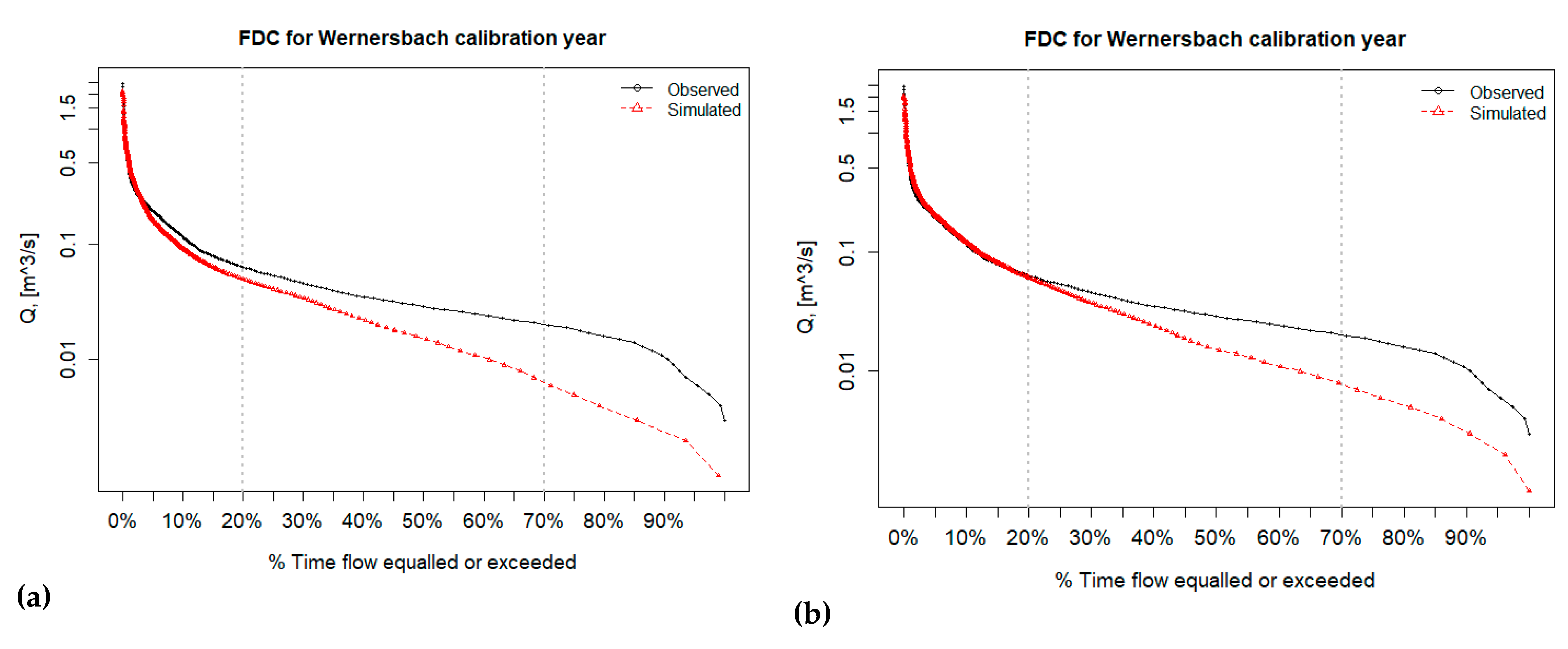

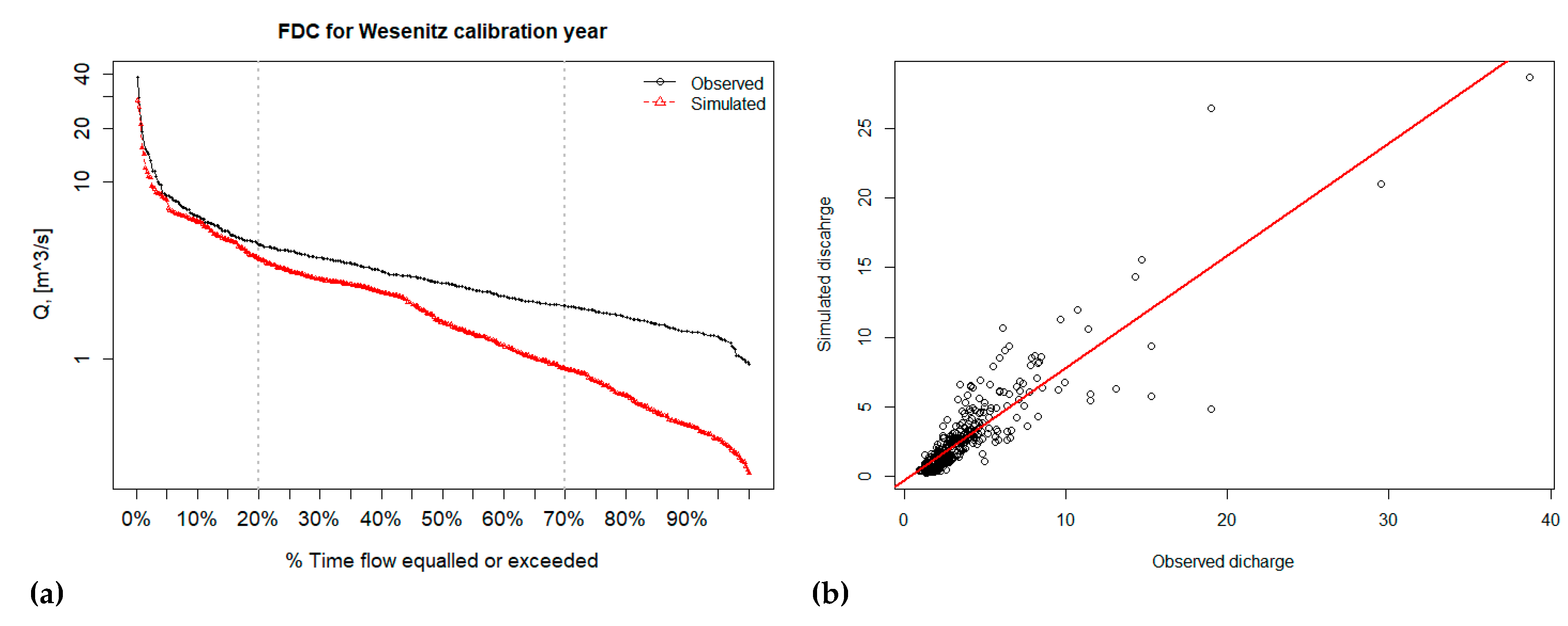
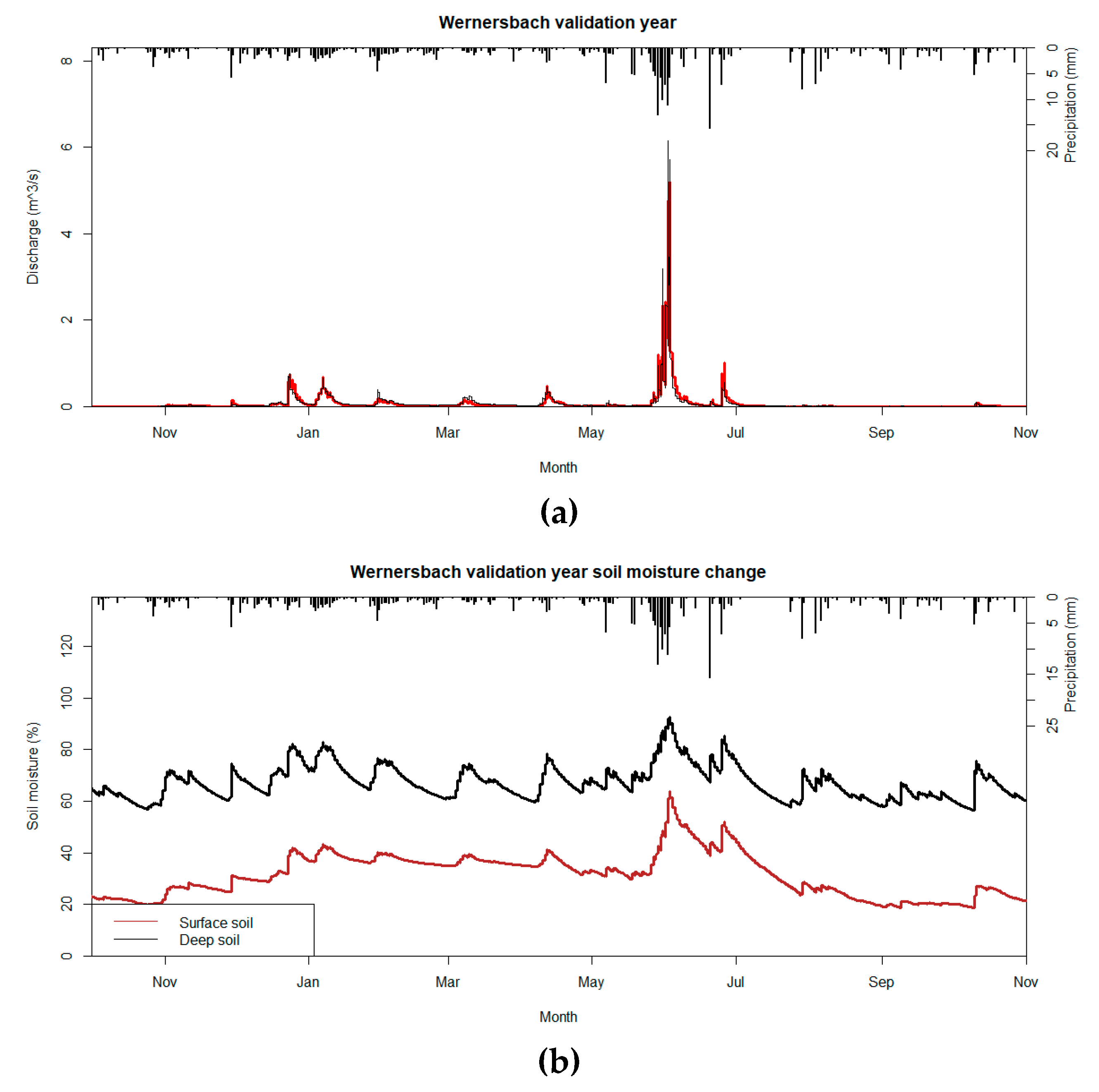
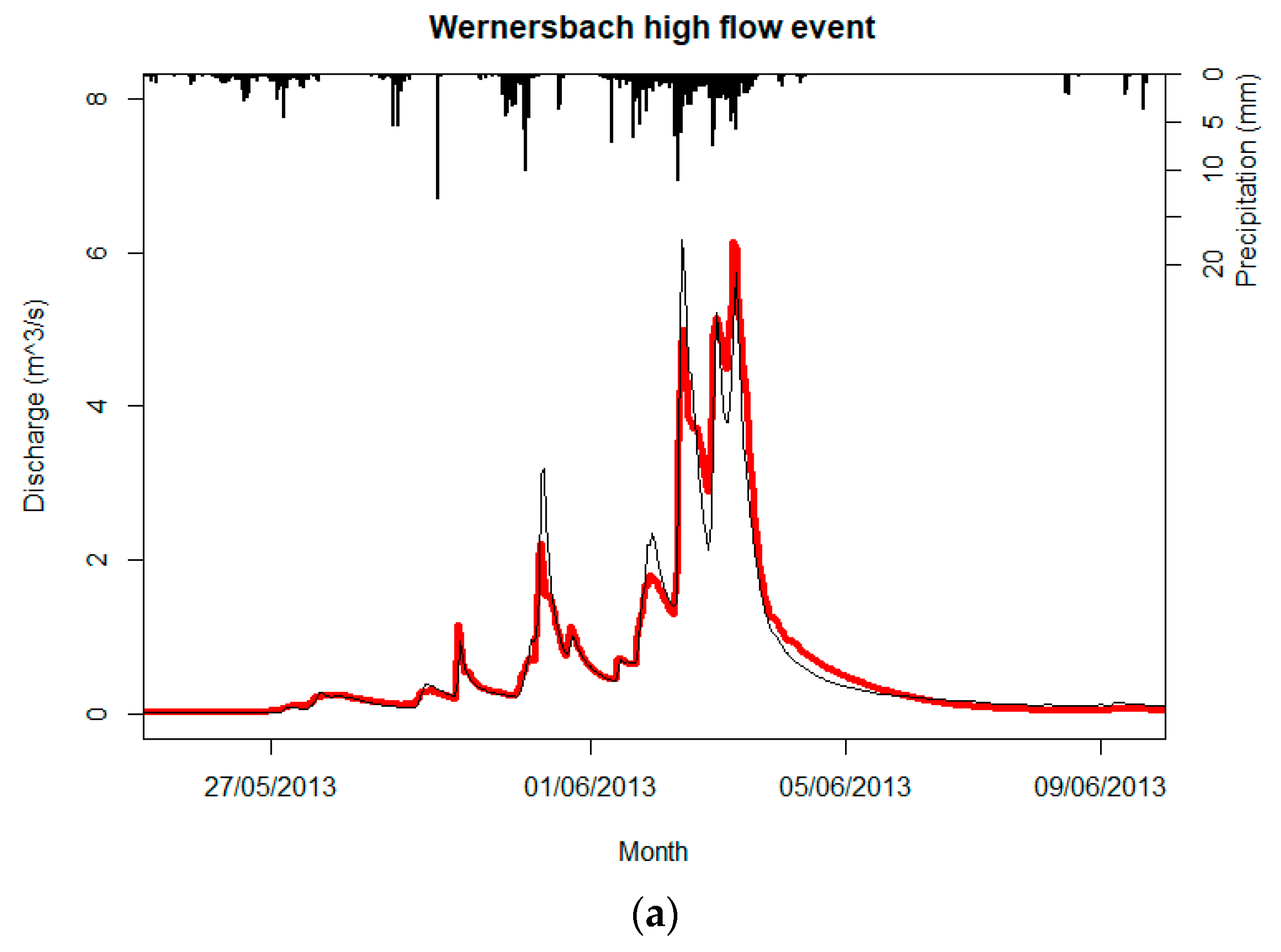
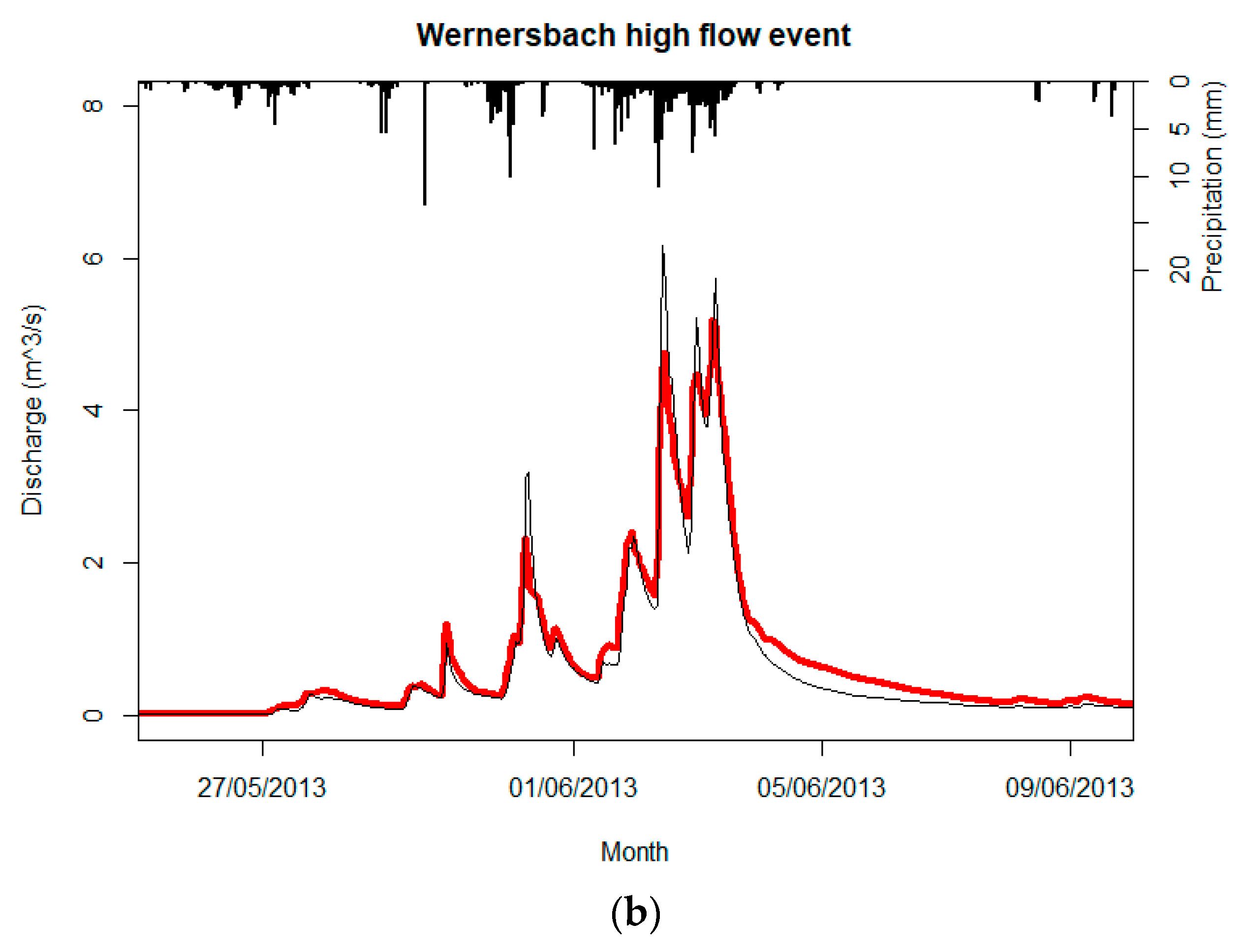
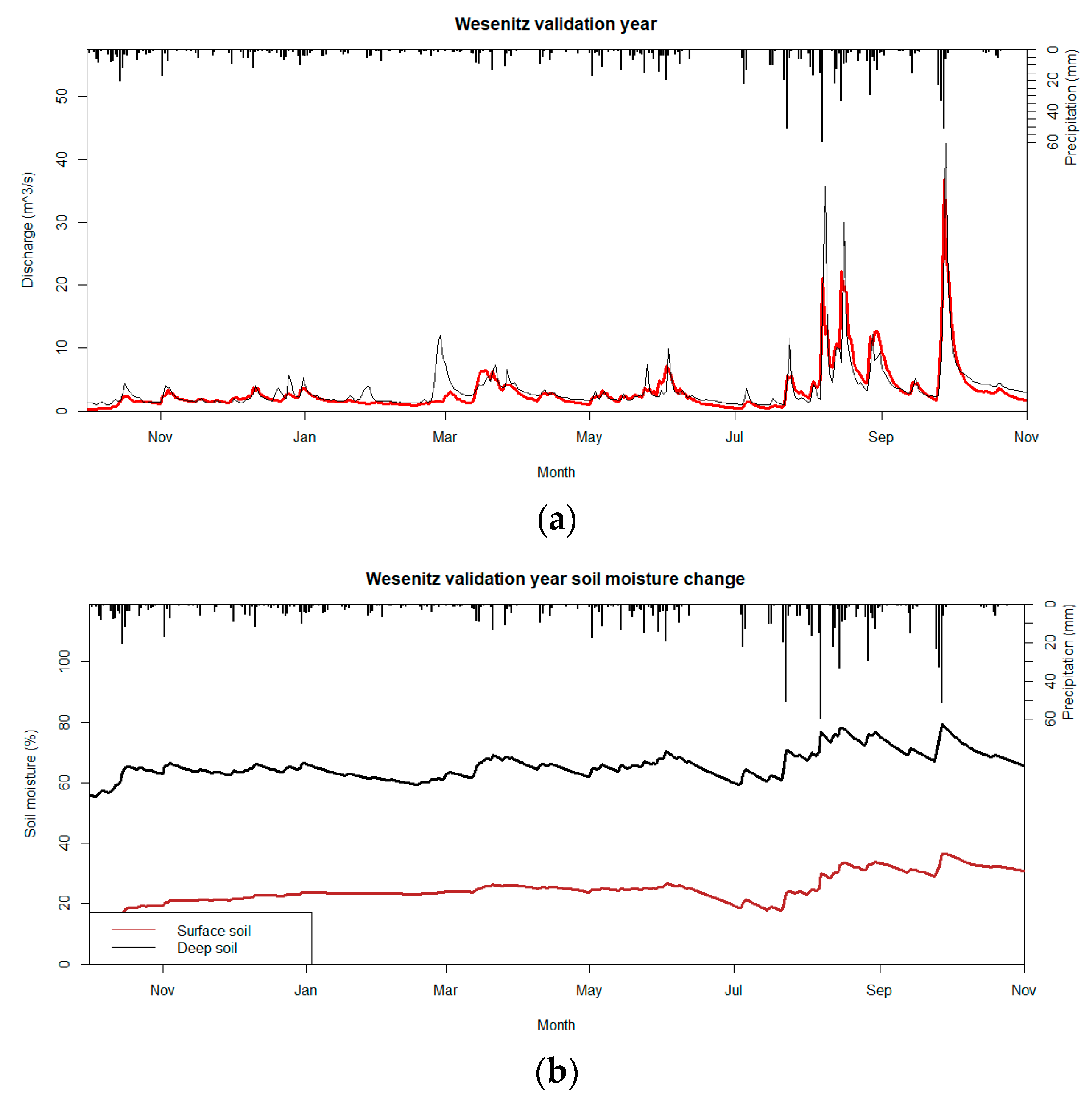
| Name | MIKE-SHE | LisFLOOD | TopNET | GeoTOP | DREAM | Arno | TOPMODEL | TOPKAPI-X |
|---|---|---|---|---|---|---|---|---|
| Type | physically based, distributed | distributed, physically based | spatially distributed, conceptual | distributed, conceptual | semi-distributed, physically based | semi-distributed, conceptual | Distributed/semi-distributed, conceptual | Physically based, distributed |
| ETP | Penman–Monteith method. Kristensen and Jensen method | Penman–Monteith method | Priestley–Taylor equation | function of saturation-specific and atmospheric specific moisture | Penman–Monteith | based on air temperature and soil moisture, Radiation method | function of given potential ETP, air T and root zone moisture storage | Thornthwaite method |
| Runoff formation | infiltration excess and saturation excess flow | Direct runoff and infiltration excess | infiltration excess and saturation excess flow | infiltration excess and saturation excess flow | exfiltration from subsurface groundwater flow | function of variable capacity of the soil | infiltration excess and saturation excess flow | infiltration excess and saturation excess flow |
| Groundwater | saturated-2D Boussinesq equation | parallel linear reservoirs | function of topographic gradients | 3D Richards equation | global linear reservoir model | Nash model | Darcy’s Law | 1D Richards |
| Soil moisture balance | function of rainfall, ETP, interflow etc. | van Genuchten’s equation | concept of topographic index | Combination of heat and water flow equations | Kirkby’s wetness index | Todini (1988) equation | steady state integral equations | function of several parameters |
| Infiltration | function of antecedent soil moisture | Smith–Parlange method | gravity drainage and Green-Ampt | 3D Richards equation | function of soil saturation capacity | function of non-linear law | non-linear reservoir function | saturation excess |
| Interpolation | Bilinear algorithm | Inverse distance method | Delauney triangles. | Kriging | Thiessen polygon | Thiessen polygons | triangular weighting function | Thiessen |
| Overland routing | 2D diffusive wave St.Venant equation | four-point finite difference solution of the kinematic wave with Manning equation | replaced by the time delay to simulate travel time in the basin | kinematic scheme, which accounts for subgrid rilling and roughness | function of flowpath, relative flowtime and Manning equation | using linear parabolic models | Distance related delay based on a constant overland flow velocity and routing distance | kinematic wave approximation St.Venant equation |
| Channel routing | 1D full dynamic wave St.Venant equation | four-point finite difference solution of the kinematic wave with Manning equation | 1D Lagrangian kinematic scheme, Kinematic wave routing | de Saint Venant parabolic equation using a constant celerity | function of flowpath, relative flowtime and Manning equation | using linear/concentrated input parabolic model | different routing options possible (e.g., constant velocity, gamma function) | kinematic wave approximation St.Venant equation |
| References | [44,45,46,47,48] | [49,50,51] | [33,52,53] | [54,55,56,57] | [58] | [59,60,61] | [62,63,64,65,66,67] | [32,68,69] |
| Wernersbach | Wesenitz | |
|---|---|---|
| Original DEM resolution (m) | 10 m | 30 m |
| D.E.M. source | TU Dresden Institute of Hydrology and Meteorology | USGS. Earth Explorer |
| DEM type | Satellite-based | Satellite-based |
| Land cover map format | shapefile | shapefile |
| Land use map source | Earth Observation center | Earth Observation center |
| Original scale of Land cover map | 1:100,000. | 1:100,000. |
| Soil type map format | shapefile | shapefile |
| Soil cover map source | Federal Institute for Geosciences and Natural Resources | Federal Institute for Geosciences and Natural Resources |
| Original scale of Soil type map | 1:200,000 | 1:200,000 |
| Meteorological data source | Climate Data Center of DWD. | Climate Data Center of DWD. |
| Meteorological data time scale | Hourly | Daily |
| Land Cover | Manning’s n | Crop Coefficients | |||||||||||
|---|---|---|---|---|---|---|---|---|---|---|---|---|---|
| 1 | 2 | 3 | 4 | 5 | 6 | 7 | 8 | 9 | 10 | 11 | 12 | ||
| Coniferous Forest | 0.127 | 1 | 1 | 1 | 1 | 1 | 1 | 1 | 1 | 1 | 1 | 1 | 1 |
| Transitional Woodland Shrub | 0.058 | 0 | 0 | 0.8 | 0.8 | 0.8 | 1 | 1 | 1 | 0.95 | 0.95 | 0 | 0 |
| Land Cover | Manning’s n | Crop Coefficients | |||||||||||
|---|---|---|---|---|---|---|---|---|---|---|---|---|---|
| 1 | 2 | 3 | 4 | 5 | 6 | 7 | 8 | 9 | 10 | 11 | 12 | ||
| Discontinuous urban fabric | 0.115 | 0 | 0 | 0.1 | 0.1 | 0.1 | 0.3 | 0.3 | 0.3 | 0.2 | 0.2 | 0 | 0 |
| Industrial or commercial units | 0.23 | 0 | 0 | 0.2 | 0.2 | 0.2 | 0.4 | 0.4 | 0.4 | 0.3 | 0.3 | 0 | 0 |
| Mineral extraction sites | 0.104 | 0 | 0 | 0.16 | 0.16 | 0.16 | 0.4 | 0.4 | 0.36 | 0.3 | 0.3 | 0 | 0 |
| Sport and leisure facilities | 0.023 | 0 | 0 | 0.1 | 0.1 | 0.1 | 0.3 | 0.3 | 0.3 | 0.2 | 0.2 | 0 | 0 |
| Non-irrigated arable land | 0.043 | 0 | 0 | 1.1 | 1.1 | 1.1 | 1.4 | 1.4 | 1.35 | 1.3 | 1.3 | 0 | 0 |
| Pastures | 0.298 | 0 | 0 | 0.4 | 0.4 | 0.4 | 0.9 | 0.9 | 0.9 | 0.8 | 0.8 | 0 | 0 |
| Agricultural land with significant areas of natural vegetation | 0.058 | 0 | 0 | 0.7 | 0.7 | 0.7 | 1.2 | 1.2 | 1.15 | 1 | 1 | 0 | 0 |
| Broad-leaved forest | 0.28 | 0.6 | 0.6 | 1.3 | 1.3 | 1.3 | 1.6 | 1.6 | 1.6 | 1.5 | 1.5 | 0.6 | 0.6 |
| Coniferous forest | 0.22 | 1 | 1 | 1 | 1 | 1 | 1 | 1 | 1 | 1 | 1 | 1 | 1 |
| Mixed forest | 0.28 | 0.8 | 0.8 | 1.2 | 1.2 | 1.2 | 1.5 | 1.5 | 1.5 | 1.3 | 1.3 | 0.8 | 0.8 |
| Soil Type | Ksh1 | Theta S1 | Theta R1 | Exp H1 | Ksh2 | Ksv2 | Theta S2 | Theta R2 | Exp H2 | Exp V2 |
|---|---|---|---|---|---|---|---|---|---|---|
| Loam | 6.24 × 10−6–3.24 × 10−5 | 0.35–0.47 | 0.048–0.058 | 1.2–1.8 | 2.4 × 10−6–2 × 10−5 | 4.49 × 10−9–1.24 × 10−8 | 0.4–0.43 | 0.05–0.08 | 1.2–1.5 | 18–25 |
| Sand | 8.14 × 10−4 | 0.36–0.49 | 0.05 | 2.6–2.9 | 2.02 × 10−5–1.1 × 10−4 | 4.49 × 10−9–1.09 × 10−6 | 0.36-0.48 | 0.04–0.07 | 1.2–2.9 | 11.1–25 |
| Silt | 4.3 × 10−6–6.6 × 10−5 | 0.38–0.5 | 0.039–0.079 | 1.7–2.4 | 2.48 × 10−6–3.26 × 10−5 | 2.75 × 10−9–1.90 × 10−7 | 0.38-0.48 | 0.04–0.055 | 1.2–2.9 | 11.1–25 |
| Silt Loam | 4.7 × 10−5 | 0.34 | 0.06 | 2 | 1.09 × 10−6 | 1.36 × 10−7 | 0.4 | 0.049 | 2.9 | 11.1 |
| Soil Type | Ksh1 | Theta S1 | Theta R1 | Exp H1 | Ksh2 | Ksv2 | Theta S2 | Theta R2 | Exp H2 | Exp V2 |
|---|---|---|---|---|---|---|---|---|---|---|
| Clay | 3.03 × 10−6–9.1 × 10−5 | 0.4–0.51 | 0.08–0.9 | 2.5 | 2.02 × 10−6–1.09 × 10−5 | 2.2 × 10−9–1.04 × 10−8 | 0.35–0.5 | 0.05–0.1 | 2.5 | 11.1–25 |
| Loam | 1.86 × 10−6–9.28 × 10−5 | 0.4–0.5 | 0.05–0.9 | 2.5 | 1.24 × 10−6–6.07 × 10−5 | 1.1 × 10−9–5.67 × 10−8 | 0.38–0.47 | 0.035–0.1 | 2.5 | 11.1–25 |
| Loamy Sand | 1.96 × 10−6–8.14 × 10−5 | 0.33–0.41 | 0.05–0.9 | 2.5 | 2.48 × 10−6–5.43 × 10−5 | 5.45 × 10−9–5.97 × 10−8 | 0.38–0.4 | 0.05–0.1 | 2.5 | 11.1–18 |
| Sand | 1.63 × 10−4–5.96 × 10−4 | 0.31–0.51 | 0.035–0.8 | 2.5 | 5.43 × 10−5–2.17 × 10−4 | 9.95 × 10−9–1.19 × 10−7 | 0.35–0.5 | 0.05–0.1 | 2.5 | 11.1–25 |
| Silt | 3.03 × 10−6–8.4 × 10−5 | 0.3–0.5 | 0.034–0.08 | 2.5 | 1.24 × 10−6–4.48 × 10−5 | 1.03 × 10−9–2.99 × 10−7 | 0.32–0.5 | 0.05–0.1 | 2.5 | 11.1–25 |
| Silty Clay | 8.40 × 10−6–8.4 × 10−5 | 0.44–0.53 | 0.034–0.09 | 2.5 | 2.02 × 10−6–5.43 × 10−5 | 2.2 × 10−9–1.21 × 10−8 | 0.35–0.5 | 0.05–0.1 | 2.5 | 11.1–25 |
| Silty Loam | 4.39 × 10−6–8.4 × 10−5 | 0.47–0.53 | 0.034–0.085 | 2.5 | 1.24 × 10−6–9.9 × 10−5 | 1.36 × 10−9–7.7 × 10−7 | 0.25–0.5 | 0.05–0.1 | 2.5 | 11.1–25 |
| Year | Catchment | ME | MAE | RMSE | PBIAS | NSE | d | R2 | KGE | VE |
|---|---|---|---|---|---|---|---|---|---|---|
| 2010 | Wernersbach (1 layer) | −0.013 | 0.03 | 0.05 | −22 | 0.83 | 0.95 | 0.73 | 0.76 | 0.53 |
| 2010 | Wernersbach (2 layers) | −0.006 | 0.02 | 0.04 | −10 | 0.89 | 0.97 | 0.87 | 0.88 | 0.64 |
| 2013 | Wesenitz | −0.98 | 1.28 | 1.85 | −27.5 | 0.7 | 0.92 | 0.6 | 0.69 | 0.64 |
| Year | Catchment | ME | MAE | RMSE | PBIAS | NSE | d | R2 | KGE | VE |
|---|---|---|---|---|---|---|---|---|---|---|
| 2009 | Wernersbach | −0.002 | 0.015 | 0.029 | −6.9 | 0.71 | 0.92 | 0.62 | 0.84 | 0.55 |
| 2012 | Wernersbach | −0.003 | 0.01 | 0.02 | −14.2 | 0.64 | 0.91 | 0.59 | 0.78 | 0.48 |
| 2013 | Wernersbach | −0.001 | 0.021 | 0.058 | −1.4 | 0.95 | 0.99 | 0.94 | 0.97 | 0.69 |
| 2006 | Wesenitz | −0.47 | 0.68 | 1.53 | −24.9 | 0.72 | 0.9 | 0.51 | 0.59 | 0.64 |
| 2008 | Wesenitz | −0.09 | 0.7 | 0.88 | −4.3 | 0.67 | 0.93 | 0.79 | 0.73 | 0.66 |
| 2010 | Wesenitz | −0.29 | 1.08 | 2.34 | −8.7 | 0.64 | 0.9 | 0.55 | 0.79 | 0.68 |
Publisher’s Note: MDPI stays neutral with regard to jurisdictional claims in published maps and institutional affiliations. |
© 2021 by the authors. Licensee MDPI, Basel, Switzerland. This article is an open access article distributed under the terms and conditions of the Creative Commons Attribution (CC BY) license (https://creativecommons.org/licenses/by/4.0/).
Share and Cite
Janabi, F.A.; Ongdas, N.; Bernhofer, C.; Reyes Silva, J.D.; Benisch, J.; Krebs, P. Assessment of TOPKAPI-X Applicability for Flood Events Simulation in Two Small Catchments in Saxony. Hydrology 2021, 8, 109. https://doi.org/10.3390/hydrology8030109
Janabi FA, Ongdas N, Bernhofer C, Reyes Silva JD, Benisch J, Krebs P. Assessment of TOPKAPI-X Applicability for Flood Events Simulation in Two Small Catchments in Saxony. Hydrology. 2021; 8(3):109. https://doi.org/10.3390/hydrology8030109
Chicago/Turabian StyleJanabi, Firas Al, Nurlan Ongdas, Christian Bernhofer, Julian David Reyes Silva, Jakob Benisch, and Peter Krebs. 2021. "Assessment of TOPKAPI-X Applicability for Flood Events Simulation in Two Small Catchments in Saxony" Hydrology 8, no. 3: 109. https://doi.org/10.3390/hydrology8030109
APA StyleJanabi, F. A., Ongdas, N., Bernhofer, C., Reyes Silva, J. D., Benisch, J., & Krebs, P. (2021). Assessment of TOPKAPI-X Applicability for Flood Events Simulation in Two Small Catchments in Saxony. Hydrology, 8(3), 109. https://doi.org/10.3390/hydrology8030109








